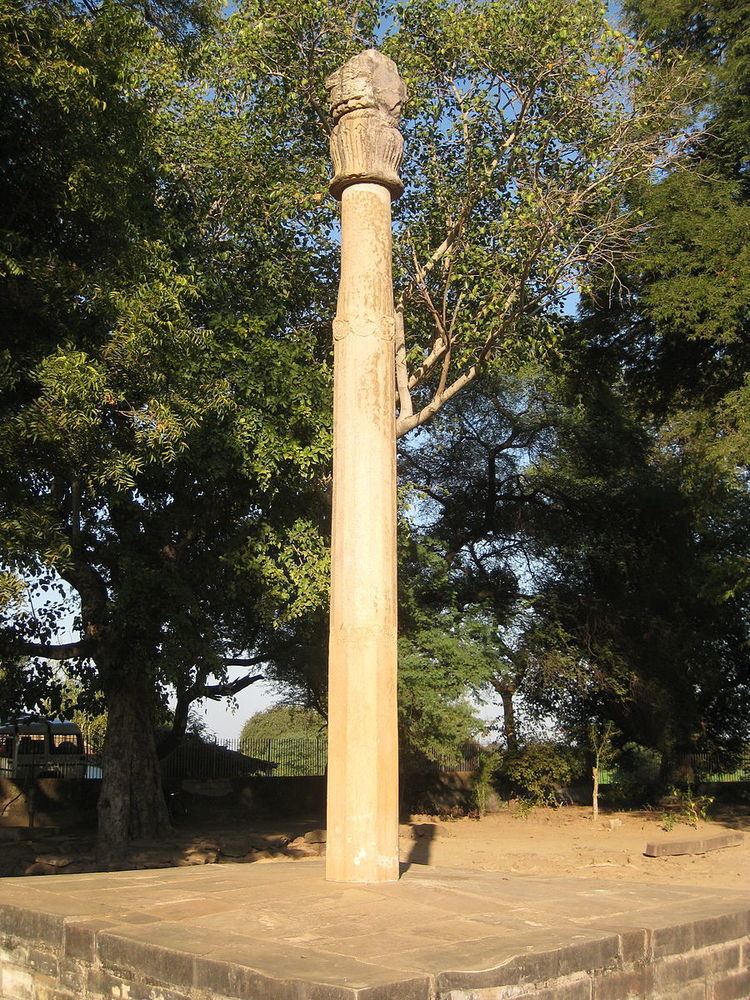 | ||
Hours Open today · 8AM–6PMThursday8AM–6PMFriday8AM–6PMSaturday8AM–6PMSunday(Holi)8AM–6PMHours might differMonday(Holi)8AM–6PMHours might differTuesday8AM–6PMWednesday8AM–6PM Similar Udayagiri Caves, Indore Museum, Brahma Temple, Chitragupta temple - Khajuraho, Vikram Kirti Mandir | ||
Heliodorus pillar kham baba vidisha
The Heliodorus pillar is a stone column that was erected around 113 BCE in central India in Vidisha near modern Besnagar, by Heliodorus, a Greek ambassador of the Indo-Greek king Antialcidas to the court of the Shunga king Bhagabhadra. Historically, it is the first known inscription related to the Bhagavata cult in India. The site is located 5 miles from the Buddhist stupa of Sanchi.
Contents
The pillar was surmounted by a sculpture of Garuda and was apparently dedicated by Heliodorus to the god Vāsudeva in front of the temple of Vāsudeva.
Inscriptions
There are two inscriptions on the pillar.
The first inscription describes in Brahmi script the situation of Heliodorus and his relationship to the Shunga Empire and the Indo-Greek Kingdom.
Although not perfectly clear, the inscription seems to be referring to Heliodoros as a Bhagavata, "One devoted to Bhagavan", meaning "a devotee".
The second inscription on the pillar describes in more detail the spiritual content of the faith supported by Heliodorus:
Richard Salomon gives a similar but slightly different translation:
"This Garuda-pillar of Vãsudeva, the god of gods, was constructed here by Heliodora, the Bhãgavata, son of Diya, of Takhkhasilã, the Greek ambassador who came from the Great King Amtalikita to King Kãsîputra Bhãgabhadra, the Savior, prospering in (his) fourteenth regnal year. (These?) three steps to immortality, when correctly followed, lead to heaven: control, generosity, and attention.
Context
The pillar was surmounted by a sculpture of the eagle Garuda and was apparently dedicated by Heliodorus to Vāsudeva, called god of gods, in front of the temple of Vasudeva. He is the earliest recorded converts to the Vaishnava tradition of Hinduism. An earlier Greco-Bactrian king Agathocles also minted coins with the image of Hindu gods circa 180 BCE.
Coins minted during the time period of Antialcidas depict Zeus with a lotus-tipped sceptre, in front of an elephant with a bell (symbol of Taxila), surmouted by Nike holding a wreath, crowning the elephant. The coins carry the inscription "BASILEOS NIKEPHOROU ANTIALKIDOU". These coins were also minted at the Pushkalavati mint and carry the same inscription in Kharoṣṭhī script.
Zeus' Eagle messenger and companion Aetos Dios, was considered as Zeus himself.
"When you [Zeus] were an eagle, when you picked up the boy [Ganymede] on the slopes of Teukrian Ida with greedy gentle claw, and brought him to heaven." - Nonnus, Dionysiaca 10. 308 ff
Aetos Dios was also considered a "messenger of God (Zeus)" and adopted by the Greek and Roman military:
"he put a golden eagle on his war standards and dedicated it as a protection for his valour" - Anacreon, Fragment 505d (from Fulgentius, Mythologies) (trans. Campbell, Vol. Greek Lyric II) (Greek lyric 6th century BC)
Professor Kunja Govinda Goswami of Calcutta University concludes that Heliodorus "was well acquainted with the texts dealing with the Bhagavata religion."
Based on this evidence it has been suggested that Heliodorus is one of the earliest Westerner on record to convert to Vaishnavism whose evidence has survived. But some scholars, most notably A. L. Basham and Thomas Hopkins, are of the opinion that Heliodorus was not the earliest Greek to convert to Bhagavata Krishnaism. Hopkins, chairman of the department of religious studies at Franklin and Marshall College, has said, "Heliodorus was presumably not the earliest Greek who was converted to Vaishnava devotional practices although he might have been the one to erect a column that is still extant. Certainly there were numerous others including the king who sent him as an ambassador."
